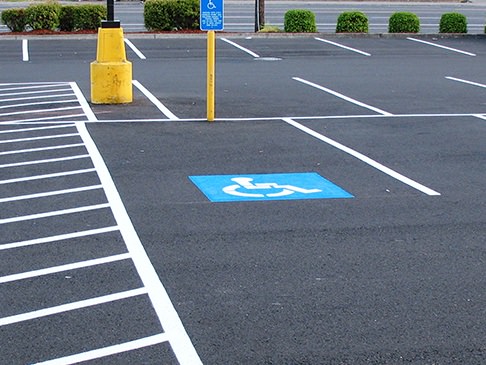Asphalt striping plays a crucial role in ensuring safety and organization within school and university environments. Beyond mere aesthetics, well-maintained and strategically marked asphalt striping contribute significantly to the overall safety of students, faculty, and visitors. Firstly, clear and visible markings help to delineate parking spaces, guiding drivers to park in an orderly manner. This not only maximizes the parking capacity but also reduces the risk of accidents caused by overcrowding or improper parking. For educational institutions, where large numbers of people commute daily, efficient use of space through proper striping is essential for smooth traffic flow and pedestrian safety. Moreover, designated handicapped parking spaces are legally mandated and must be clearly marked according to accessibility guidelines. These spaces ensure that individuals with disabilities have convenient access to educational facilities, promoting inclusivity and compliance with accessibility laws. Properly striped crosswalks and pedestrian pathways further enhance safety by clearly indicating routes that should be prioritized by both drivers and pedestrians.

Additionally, striping can be utilized to designate loading zones, fire lanes, and other restricted areas. These markings are crucial for emergency preparedness and response, allowing emergency vehicles quick and unobstructed access when needed. By clearly delineating these zones, schools and universities ensure compliance with local regulations and enhance their ability to handle emergency situations effectively. Furthermore, striping plays a role in enhancing overall campus aesthetics and branding. Consistently maintained and freshly painted lines convey a sense of organization and care, reflecting positively on the institution’s image. This attention to detail can contribute to a welcoming environment for students, staff, and visitors alike, fostering a sense of pride and professionalism within the campus community. In terms of practical considerations, regular maintenance of asphalt striping is essential. Over time, weather conditions, vehicle traffic, and general wear can cause striping to fade or become less distinct. Periodic re-striping not only ensures continued visibility but also demonstrates a commitment to safety and operational efficiency.
It is advisable for schools and universities to establish a maintenance schedule and work with professional striping services to uphold these standards. Moreover, advancements in striping materials and techniques offer additional benefits. Reflective paints and thermoplastic materials improve visibility at night and in adverse weather conditions, further enhancing safety for everyone on campus. These modern materials also tend to be more durable, reducing the frequency of re-striping and maintenance costs over time. In conclusion, asphalt striping is far more than a cosmetic concern for schools and universities; it is a critical element in promoting safety, efficiency, and compliance within campus environments. By investing in clear, well-maintained markings, educational institutions prioritize the well-being of their community members and create an environment conducive to learning and productivity. Effective striping strategies not only enhance safety and organization but also contribute to the overall positive experience of students, faculty, staff, and visitors on campus.